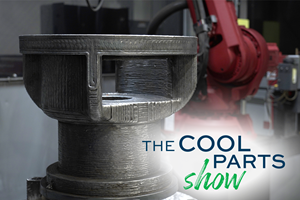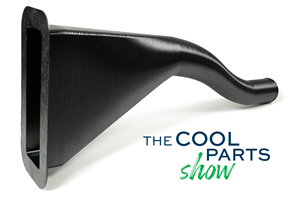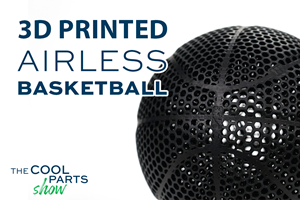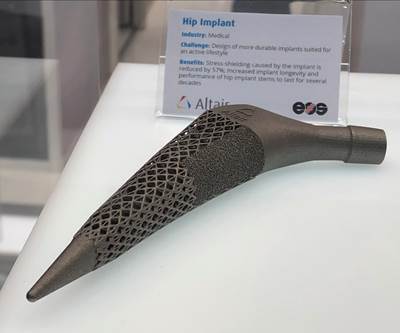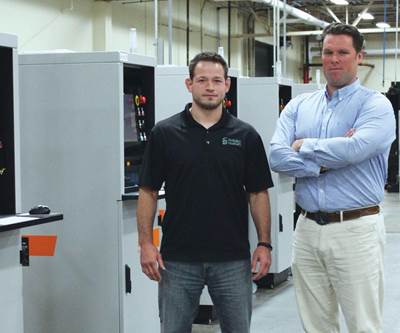Topology Optimized 3D Printed Spine Implant: The Cool Parts Show #2
Medical contract manufacturer Tangible Solutions shares a titanium 3D printed spine implant with an unusual lattice structure in this episode of The Cool Parts Show.
Lattices are a common feature in 3D printed spine implants for their ability to encourage better bone in-growth and therefore faster healing without stress shielding in patients. However, most lattices are regular structures, equally spaced inside the part’s volume. In this episode of The Cool Parts Show, medical contract manufacturer Tangible Solutions shares with us a different kind of latticed implant, one created with topology optimization software from nTopology.
The Cool Parts Show is a video series from Additive Manufacturing Media that explores the what, how and why of unusual 3D printed parts. Watch more here.
Have a cool part to share? Email us.
Transcript
Stephanie Hendrixson, Additive Manufacturing
What does it look like to apply topology optimization to a 3D printed spine implant? You'll see it in this episode of The Cool Parts Show.
Pete Zelinski, Additive Manufacturing
I'm Pete Zelinski.
Stephanie Hendrixson
And I'm Stephanie Hendrixson.
Pete Zelinski
We're with AdditiveManufacturing.media and this is The Cool Parts Show.
Stephanie Hendrixson
This is the second episode of our new series where we talk about cool parts 3D printed by viewers like you.
Pete Zelinski
Alright, challenge on you, your turn to bring a cool part. What do you got?
Stephanie Hendrixson
All right. So Pete, I'm sure you've seen 3D printed implants before. I'm thinking specifically of implants for the spine. What do those usually look like?
Pete Zelinski
So when they're 3D printed spine implants, not solid. More the form has a mesh lattice structure for bone in-growth.
Stephanie Hendrixson
Right. So what I brought today is a spine implant. It was 3D printed, it has a lattice structure. But it has a lattice that's unlike any that I've seen before.
Pete Zelinski
Yeah, so I'm used to like a regular lattice geometry, a honeycomb, or like a checkerboard. But this is a crazy purple bird's nest, right? What's going on here?
Stephanie Hendrixson
Right? So this implant was 3D printed by Tangible Solutions in Beaver Creek, Ohio, using powder bed fusion. It's made of titanium. And this could be the direction that lattices are going in the future. So I'm going to let Chris Collins, the chief operating officer at Tangible talk a little bit about what they do and why lattices are so important to their business.
Chris Collins, Tangible Solutions
Tangible Solutions makes 3D printed titanium orthopedic implants, that's 100% of our business. That's all we do, about 90 to 95% of that are spine implants. Lattices are valuable to spinal implants, because they can reduce the global stiffness of the device. And so in particular, in spine implants, it's very important to make the stiffness of the implant as close to the disc as possible. With additive and lattice, you can use the lattice to tune the stiffness of the device to lower it and bring it closer to what a intervertebral disc would be. Lattice in spine implants also aids, bone graft volume. So that'll enable the surgeon to pack the device with a larger amount of bone graft which can decrease patient recovery times and improve bony in-growth into the device.
Pete Zelinski
This is more like what I think of as lattices. And even this one would be hard to model, I think, but it's at least geometrically regular. That's not what this is. This is just craziness and no consistency. Talk me through the crazy.
Stephanie Hendrixson
So it's crazy because it was topology optimized for the loads that an implant like this would be expected to bear. So tangible used software from nTopology to optimize the directions of the struts, the the width of the struts, and even the build angle to make sure that this would print the way that they expected it to. And as a result, they're able to design this implant with the lattice that's specifically designed to serve this one particular purpose.
Pete Zelinski
Why is it purple?
Stephanie Hendrixson
So I'm glad you asked. It's purple because it's anodized titanium. And you might want to do that just to differentiate between different sizes of implants or maybe just for aesthetics. But the fact that it's anodized, and it's made of titanium is sort of interesting, because usually, when we talk about titanium implants, it looks something like this, it's a solid piece of metal. But the issue with putting something like this into your body is that this solid titanium is a lot stronger and stiffer than your natural bone. And so as your body heals around it, your bone can actually kind of get lazy, because it's depending on this really strong piece of metal.
That's why a lot of implants now are made out of this plastic called PEEK. Because it's a little bit less stiff, it's a little bit closer to the natural characteristics of your bone. However, when you topology optimize, and 3D print a titanium implant like this, you can actually adjust the stiffness and so you end up with something that's a lot closer to your natural bone that your body can then heal around, and you don't end up with that sort of laziness in your spine.
Pete Zelinski
Alright, so that's a lot. Let me see if I got that. With topology optimization software as part of the design, you could put the lattices to work for you. You can get the strength that you want precisely, you can get the flexibility, stiffness that you want. By applying that to the software and letting the software create the lattice form, no matter how crazy it is, to give exactly those structural properties. And then you can get that in addition to the other reasons you use lattices, which in the case of an implant is the area for bone to grow into. Anchor the bone better, and speed recovery time. Is that right?
Stephanie Hendrixson
Right, exactly. And so this is a really specific use case, in a really specific industry. It's not even something that necessarily is going into bodies yet. But you can see how the ability to topology optimize your lattice could be used in a lot of different scenarios where you want to remove material, but you also want to impart some other sort of characteristics to your part.
Pete Zelinski
So you're saying it's bigger than implants. We could see lattice parts, lightweight and strong, everywhere.
Stephanie Hendrixson
Yeah, I think that's definitely where we're going. That's it for this episode of The Cool Parts Show. If you have a cool part you'd like to see featured, Email us at coolparts@additivemanufacturing.media. Thanks for watching. Don't forget to subscribe.
Related Content
8 Cool Parts From Formnext 2023: The Cool Parts Show #65
New additive manufacturing technologies on display at Formnext were in many cases producing notable end-use components. Here are some of the coolest parts we found at this year’s show.
Read More500-Pound Replacement Part 3D Printed by Robot: The Cool Parts Show #50
Our biggest metal cool part so far: Wire arc additive manufacturing delivers a replacement (and upgrade) for a critical bearing housing on a large piece of industrial machinery.
Read MoreAircraft Ducts 3D Printed in Composite Instead of Metal: The Cool Parts Show #68
Eaton’s new reinforced PEKK, tailored to aircraft applications, provides a cheaper and faster way to make ducts compared to formed aluminum.
Read MoreAirless Basketball Shows Promise of 3D Printed Lattices: The Cool Parts Show Bonus
Successfully matching the performance of a standard basketball demonstrates the control possible over the mechanical properties of digital materials.
Read MoreRead Next
How Topology Optimization Could Be the Key to Longer-Lasting Hip Implants
Hip stem implants must support the mechanical loads of the patient’s lifestyle, but should also avoid stress shielding. A team from Altair leveraged simulation, topology optimization and 3D printing to design an optimized hip stem that meets both conditions.
Read MoreBuilding an Additive Manufacturing Business for Production
What does it look like to build a business based on AM production from the ground up? An Ohio medical device contractor is finding out.
Read MoreHybrid Additive Manufacturing Machine Tools Continue to Make Gains (Includes Video)
The hybrid machine tool is an idea that continues to advance. Two important developments of recent years expand the possibilities for this platform.
Read More
.jpg;width=70;height=70;mode=crop)










